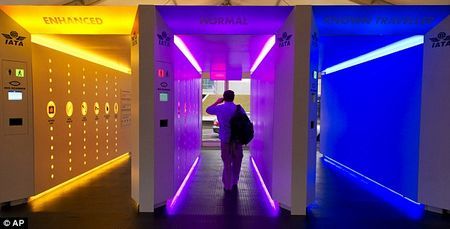翻译业务咨询
当前位置:返回首页 >> 翻译新闻
英语读报—未来安检区Checkpoint of the future
未来安检区Checkpoint of the future

The laborious - and at times invasive - process of passing through airport security is enough to put many holidaymakers off air travel.
But if designs for the future of check-in security ever come to fruition, millions of travellers will heave a collective sigh of relief.
A mock-up "checkpoint of the future" has gone on display at the Aviation Security World Conference in Amsterdam, including hi-tech colour-coded scanning corridors.
Passengers are guided into one of three corridors upon presenting their passports: blue for frequent travellers, purple for normal passengers and orange for those deemed to require enhanced vetting.
People do not have to empty their pockets, remove any of their clothing or subject themselves to pat-downs before walking through a 20-foot tunnel that scans metals, liquids, laptops and other potential dangers one by one.
International Air Transport Association chief Tony Tyler said: "We spend too much time on the 99.9 percent who mean us no harm, when threat detection surely should be focused on those with greater potential to do damage."
"By making our checkpoints smarter, and using 'known traveller' programmes, we can give everybody a baseline level of security...and in the end get everybody through security much faster."
However, the concept faces technical and financial hurdles, and is likely to be opposed by people who object to profiling or believe passing through body scanners violates their privacy. But it indicates the direction the industry hopes to go, Mr Tyler said.
He argued the "risk-based approach" is not the same as profiling, since it does not use ethnic or religious data.
It relies partly on pre-flight information submitted by passengers, partly on biometric scans and data stored in passports, and partly on human observers who would have the discretion to choose a more rigorous scan for someone acting suspiciously.
US Transport Security Authority (TSA) chief John Pistole said the checkpoint-of-the-future idea parallels the TSA's own new emphasis on "risk-based security".
"It's an idea clearly worth consideration as technology develops,"he said. "Segmenting the passenger population for different levels of security screening is exactly what we're pursuing."
英国《每日邮报》7日报道译文:
费力,有时还有点侵袭性的机场安检过程足以把乘飞机旅行的度假者们吓跑。
但如果(下面)这个未来安检区成行,数百万的旅行者将舒口气。
在阿姆斯特丹世界航空安全大会上,包含一个高科技彩色码扫描通道的模拟“未来安检点”亮相了。
(在这里),根据出示的护照,乘客会被引导进入不同颜色的通道。蓝色为常客通道,紫色为普通旅客入口,而橘色通道则为有待进一步检查的游客设计。
走进这个20英尺高的通道前,乘客无需掏空口袋,也不用去除身上任何衣物或者被搜身。通道能一一扫描金属、液体、笔记本以及其他潜在的危险品。
“当安检确实需要我们专注于更可能制造危险的人们时,我们却把太多时间花在了99.9% 对我们没有任何威胁的人身上”,国际航空运输协会主席托尼-泰勒表示。
“通过使我们的安检点更智能,同时利用’熟客’程序,我们可以给每个人提供一个安全底线…最终让每个人都能更快地通过安检。”
但是,这一概念也有其技术和资金上的障碍。它可能会被一些不愿做侧像或者认为身体扫描仪侵犯其隐私的人所反对。 但这(项技术)反映了这一领域希望发展的方向,泰勒说。
泰勒指出,这条“基于风险的通路”和做外观描述还不一样,因为它并不调用种族和宗教数据。
它部分倚赖乘客乘机前提供的信息,同时仰仗来自生态扫描和储存在护照中的数据,并部分依靠真人观察。真人观察可以对行为可疑的人审慎地进行更为严格的扫描。
美国运输安全局主席约翰-皮斯托尔称,这一未来安检点的设想与该局“基于风险的安全”新策略重点一致。
“随着科技的进步,这无疑是一个值得考虑的理念”,皮尔斯托说,“将乘客分类进行不同水平的安检扫描正是我们所需要的”。
英语阅读学习 - 捷优翻译公司 - Devin
[来源:原创]
[作者:Devin]
[日期:11-10-09]
[热度:]
最新文章
房产证翻译,移民旅游探亲签证英语翻译05.03
家电设备产品技术资料说明书手册合同翻..02.09
无锡市仪器仪表设备产品技术说明书翻译12.06
无锡化工设备产品技术说明书手册合同英..11.14
无锡电力设备产品技术说明书手册合同翻..09.18
无锡公司设备产品技术资料文件翻译08.04





 英语
英语 日语
日语 韩语
韩语 俄语
俄语 德语
德语 法语
法语 阿语
阿语 葡语
葡语 蒙语
蒙语 西语
西语 意语
意语 瑞语
瑞语 波语
波语 荷语
荷语

